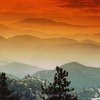Arizona, in the heart of the American Southwest, is home to some of the country’s most arresting scenery. Its most celebrated landform, the Grand Canyon, is an international icon, a UNESCO World Heritage Site and a peerless display of the geological process. From the lonesome mesa tops of the Colorado Plateau to cactus-studded benches of the borderland deserts, Arizona squares off in its boundaries a head-spinning tapestry of terrain.
General Topography
From a geological perspective, Arizona is commonly divided into three regions. North-central and northeastern Arizona belong to the Colorado Plateau, a spectacular region of uplifted, roughly horizontal beds of sedimentary rocks – strung here and there with volcanic formations – that has been extensively eroded. Plateaus, mesas, buttes, tremendous canyons, hoodoos and other wild rock formations define the region; human settlements are few and far between. Western and southern Arizona lie in the Basin-and-Range Province, a lower region of scattered mountain ranges and desert valleys. While much of it is sparsely populated, it also harbors Arizona’s biggest cities, including Phoenix and Tucson. The Colorado Plateau buckles to the Basin-and-Range country in the rugged Transition Zone, which slants across the state from the northwest to the southeast.
The Grand Canyon
Arizona’s Grand Canyon is the titanic gorge of the Colorado River and its tributaries in the southwestern portion of the Colorado Plateau. At its broadest and deepest it is 18 miles across and 6,000 feet deep, but the physical dimensions are only part of its majesty: Billions of years of geological history are exposed in dramatically multicolored rock strata, plunging from rim to gorge depths. Grand Canyon National Park is the no-brainer anchor to a geological tour of Arizona; you can gape from the North or South Rim, hike into the hot canyon maw or wander cool, high forests of spruce and fir.
The Painted Desert
Northeastern Arizona’s portion of the Colorado Plateau is called the Navajo Section – the vast lands of the Navajo Nation, which also extend into Utah and New Mexico, lie here – and includes a tract of colorful badlands, mesas and scarps known as the Painted Desert. Petrified Forest National Park showcases the banded knobs, cobble-strewn gullies and grasslands of the region, as well as an outstanding collection of fossils -- most famously, petrified logs better than 200 million years old.
Mogollon Rim
A belt of mighty escarpments marking the Transition Zone, the Mogollon Rim is one of Arizona’s major landmarks and a significant geological and ecological frontier. With sheer cliffs as high as 2,000 feet in places, the rim drops from high-elevation mixed-conifer woods allied to the Colorado Plateau and Rocky Mountains to desert scrub far below. The Coconino National Forest provides stellar opportunities to explore the Mogollon; the Rim Road/General Cook Trail Loop, for example, offers motorists long views off the escarpment.
Sky Islands
A series of isolated mountain ranges looming from Chihuahuan Desert grasslands in southeastern Arizona and adjoining portions of New Mexico and northern Mexico, the Madrean Sky Islands – sometimes called the Madrean Archipelago – are hotspots for biological diversity. Some geologists consider them northern outliers of Mexico’s Sierra Madre Occidental. Their higher elevations include the most southerly populations of certain temperate trees and shrubs, while their foothills support northerly extensions of subtropical species; many of the ranges include endemic organisms found nowhere else. A fantastic place to explore a Madrean Sky Island is the Chiricahua National Monument in southeastern Arizona, where the wild, volcanic Chiricahua Mountains loom beyond 9,000 feet. These rugged peaks boast more than 1,000 species of native plants.
References
- Britannica Online Encyclopedia: Arizona
- National Park Service: Grand Canyon National Park - Natural Features and Ecosystems
- Natural Landscapes of the United States; James A. Henry, Joann Mossa
- National Park Service: Petrified Forest National Park - Fossils
- USDA Forest Service: Coconino National Forest - Mogollon Rim Ranger District
- Terrestrial Ecoregions of North America: A Conservation Assessment; Taylor H. Ricketts, et al.
- National Park Service: Chiricahua National Monument - Plants
Resources
Photo Credits
- Comstock/Comstock/Getty Images




